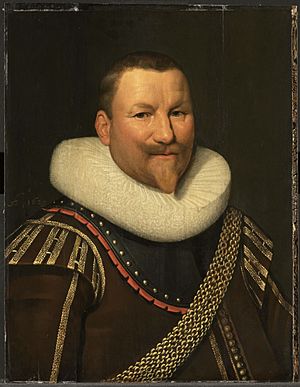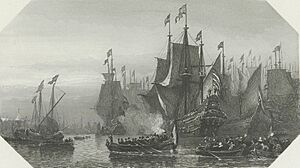Piet Pieterszoon Hein facts for kids
Quick facts for kids
Piet Hein
|
|
|---|---|
 |
|
| Birth name | Piet Pietersen Heyn |
| Born | 25 November 1577 Delfshaven, County of Holland |
| Died | 18 June 1629 (aged 51) |
| Allegiance | |
| Battles/wars |
|
Piet Pieterszoon Hein (born November 25, 1577 – died June 18, 1629) was a famous Dutch admiral and privateer. A privateer was like a legal pirate, hired by a government to attack enemy ships. Piet Hein is best known for capturing a huge Spanish treasure fleet. This fleet was carrying lots of gold and silver from Spanish America to Spain. His capture of this fleet was so big that it caused the price of silver to go up around the world. It also almost made Spain go bankrupt!
Contents
Early Life and Challenges
Piet Hein was born in Delfshaven, which is now part of Rotterdam in the Netherlands. His father was a sea captain, so Piet started sailing when he was still a teenager. Even though he loved the sea, he often suffered from severe motion sickness on his first trips.
When he was in his twenties, Spanish forces captured him. He was forced to work as a galley slave for about four years, from around 1598 to 1602. Galley slaves had to row large ships. He was later traded for Spanish prisoners. He was captured again by the Spanish near Cuba between 1603 and 1607.
A Career at Sea
Joining the Dutch East India Company
In 1607, Piet Hein joined the Dutch East India Company. This company was very powerful and traded with countries in Asia. He sailed to Asia and returned five years later as a captain. After his return, he married Anneke Claesdochter de Reus and settled in Rotterdam. In 1618, while he was captain of a ship called the Neptunus, he and his ship were asked to serve the Republic of Venice. By 1621, he left his ship and traveled back to the Netherlands by land.
For a year in 1622, he worked in the local government of Rotterdam. This was special because he wasn't officially a citizen of the city. His wife's cousin, who was a mayor, helped make it possible.
Working for the Dutch West India Company
In 1623, Piet Hein became a vice-admiral for the new Dutch West India Company. This company aimed to control trade in the Americas and Africa. They planned to capture important cities like Salvador in Brazil and Luanda in Angola. This would give them control over valuable sugar plantations and the trade of enslaved people.
In 1624, Hein sailed to the Caribbean. In Colonial Brazil, he successfully captured the Portuguese settlement of Salvador. He personally led the attack on the sea fortress there. Later, he tried to capture Portuguese ships in the bay of Luanda in Africa, but he wasn't successful.
Privateering Adventures
After crossing the Atlantic Ocean again, Hein tried to capture merchant ships near the city of Vitória. However, local citizens and the Portuguese army fought back, and he was defeated. When he found out that Salvador had been recaptured by a large Spanish-Portuguese fleet, Hein sailed back home.
The Dutch West India Company was happy with Hein's leadership. In 1626, they gave him command of a new group of ships. In 1627, he raided Salvador again. This time, he captured over 30 Portuguese merchant ships that were full of valuable goods. He then returned to the Dutch Republic.
Capturing the Spanish Treasure Fleet
In 1628, during the long war between the Dutch and Spain, Admiral Hein set out to capture a Spanish treasure fleet. This fleet was carrying huge amounts of silver from Spanish colonies in America and the Philippines. He was joined by other admirals and even a pirate named Moses Cohen Henriques.
Part of the Spanish fleet in Venezuela was warned about the Dutch attack. This happened because a Dutch cabin boy got lost and was captured, revealing the plan. However, the other half of the fleet, coming from Mexico, continued its journey without knowing the danger.
Hein's fleet intercepted and captured sixteen Spanish ships. One large ship was taken by surprise at night. Nine smaller merchant ships surrendered after being talked into it. Two small ships that tried to escape were caught at sea. Finally, four large ships, called galleons, were trapped on the Cuban coast in the Bay of Matanzas.
After some quick fighting, the crews of the Spanish galleons also surrendered. Hein captured an amazing amount of treasure: about 11.5 million guilders worth of gold, silver, and other expensive goods like indigo and cochineal. He did all this without any bloodshed. The Dutch did not take the Spanish crews as prisoners. Instead, they gave them supplies to walk to Havana. The released Spanish sailors were surprised when Admiral Hein personally gave them directions in perfect Spanish. Hein knew the area well because he had been held captive there years before.
Capturing the treasure fleet was the biggest victory for the Dutch West India Company in the Caribbean. It helped the Dutch pay for their army for eight months. This allowed them to capture an important fortress called 's-Hertogenbosch. The company's investors were very happy, receiving a 50% profit that year. This huge financial loss also made their Spanish enemies much weaker.
Hein returned to the Netherlands in 1629 and was celebrated as a hero. As he watched the crowds cheering him from a balcony in Leyden, he famously said: "Now they praise me because I gained riches without any danger. But earlier, when I risked my life in full combat, they didn't even know I existed..." Piet Hein was the first and last person to capture such a large part of a Spanish "silver fleet."
Becoming Lieutenant-Admiral
After some disagreements with the Dutch West India Company about how things should be run and about his payment, Piet Hein became Lieutenant-Admiral of Holland and West Frisia on March 26, 1629. This made him the main commander of the entire Dutch fleet.
He died that same year while fighting against the Dunkirkers. These were very effective privateers and raiders from Dunkirk who attacked Dutch trade ships. Hein's group of ships found three privateers from Ostend. He bravely sailed his own ship between two enemy ships to fire at them both at the same time. After about half an hour, a cannonball hit him in the left shoulder, and he died instantly. He is buried in the Oude Kerk (Old Church) in Delft.
Remembering Piet Hein
Many things are named in honor of Piet Hein. The Piet Hein Tunnel in Amsterdam is one example. A former Dutch warship, HNLMS Piet Heyn, was also named after him. A song praising Admiral Hein's capture of the Spanish "silver fleet" was written in 1844. It is still sung by choirs and children in primary schools in the Netherlands. It's also sung by university students in Belgium.
There are statues of him in his hometown of Delfshaven (now part of Rotterdam) and in the Cuban city of Matanzas, near where the famous silver fleet battle happened.
Views on Slavery
Piet Hein did not agree with the practice of slavery in the Spanish New World colonies. He believed it was wrong to treat other human beings in such a cruel way. Some historians suggest that his strong feelings against slavery came from his own experience. He had been held captive and forced to work as a galley slave by the Spanish for about ten years.
It is interesting to think about how his personal views on slavery fit with his work for the Dutch West India Company. This company was involved in the trade of enslaved people. Today, there is still discussion about the role of slavery in Dutch history. Piet Hein is sometimes seen as a hero, but also as a figure connected to this difficult past. In June 2020, his statue in Delfshaven was marked with graffiti.
See also
 In Spanish: Piet Hein para niños
In Spanish: Piet Hein para niños


